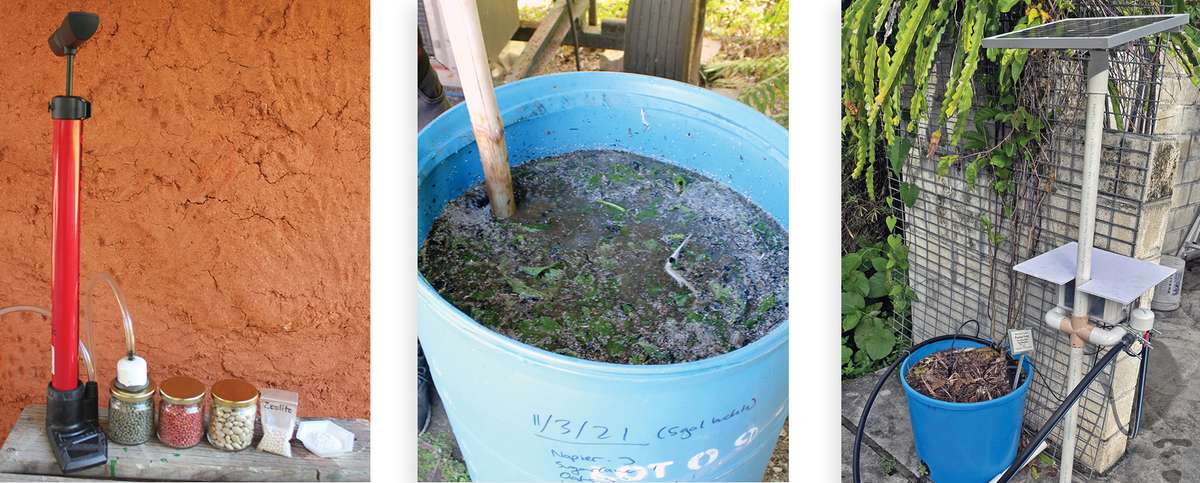Dear friends of ECHO,
We appreciate your interest in research that benefits smallholder farmers. Thank you to those who participated in the various research elements of the ECHO International Agriculture Conference last month (Nov 2024). In this Research Newsletter, we will update you on the Research Roundtable and end with a few opportunities for engagement.
Program Elements of the Research Roundtable
The informal gathering took place on November 11, 2024. Following introductions, I (Tim) shared a brief overview of research at ECHO. We then split into three groups, with each group visiting each of three stops on the ECHO North America demonstration farm. The stops were as follows:
- Seed barn: Here the focus was on low-cost technologies for storing seeds in places with high heat and humidity. Technologies such as vacuum sealing and desiccants were presented and discussed.
- Vermiculture beds: Here we talked about on-farm fertilizer options for building soil health while reducing reliance upon mineral NPK fertilizers. In addition to using worms, bioliquid fertilizer was discussed.
- Urban garden area: Growing food in small spaces has relevance to urban areas (e.g., rooftops) as well as other settings such as refugee camps and even rural household gardens. Strategies were presented for minimizing the weight of rooftop gardens (e.g., shallow-bed gardens) and maintaining moisture of planting media (e.g., wicking approaches).

Vacuum-sealing and desiccants (left), bioliquid fertilizer (middle), and an automatic waterer (right) shown at the seed barn, vermiculture area, and urban garden demonstration area of the farm, respectively.
After lunch we collectively addressed areas of research relevant to smallholder agriculture. Below I’ve synthesized the information with tables ordered by priority to smallholder farmers (voted on by participants). Participants also placed stickers beside listed “To Do” activities they thought were important initiatives to undertake. Within each table below, items in the “To Do” column are listed in order of most (top) to fewest(bottom) stickers. Items in the “Done” column are matched as best as possible to activities in the “To Do” column.
1. Building human capacity for agricultural improvements
| To Do | Done |
|---|---|
| Business management training for agriculture | Curricula developed, but limited capacity to train |
| Product/process development of best practices tool to implement research results | Training/demonstration on good agricultural practices |
| Local church pastors to be trained as farm trainers/consultants | Utilization of lead farmers and farmer fields |
| Seeing God’s attributes in His creation | Included in Farming God’s Way training materials |
| More farmer-to-farmer programs | |
| Train youth | Small pilots giving youth access to land and credit |
| Protect against corporatization of farmers | Village savings and loan associations methodology |
2. On-farm products
| To Do | Done |
|---|---|
| Identify promising homemade bio stimulants | Compost with Trichoderma application in the soil for control of fusarium |
| Introduce varieties for early harvest and delayed harvest for better market price. | On-farm Azolla production as green fertilizer, poultry feed, and water filtration |
| Moringa for seed treatment | |
| Improve on-farm or community level biochar production | Promotion of home gardening for nutrition/food security |
| Plant-based amino acids | Palm weevil production for food grown on ag waste (husks, etc.) |
| Develop lean start-up approaches | |
| Evaluate the efficacy of molasses for insect repellent | Wood ash and chili powder for control of fall armyworm |
| Train small store runners on best use of items they sell |
2. Access to varieties/resources
| To Do | Done |
|---|---|
| Local churches to become resource center input supply centers, savings/credit entities, storehouses, and/or processing centers | Some appropriate seed saving technologies encourage churches as seed banks |
| Develop best practices for on farm plant breeding | |
| Teach field plot techniques | |
| Disease resistant varieties | |
| Identify OP maize varieties with excellent performance | |
| Advocacy for governments to adopt safeguards | Global recognition of role/need to conserve biodiversity |
| Evaluate the efficacy of molasses for insect repellent |
3. Post-harvest value loss reduction and value addition
| To Do | Done |
|---|---|
| Village scale processing into value added products | Locally made solar dryers/PICs bag research |
| Appropriate small grain stores | |
| Storing pressed oils from fruits/seeds rather than the fruit/seed themselves | |
| Connect end use markets with small-scale producers | Small-scale coffee roasting (educating/training farmers) |
| Bypass corruption (e.g. corrupt middleman) | Warehouse guarantee system |
| Time production to high value season | Underground tuber storage methods |
4. Pastoralist care
| To Do | Done |
|---|---|
| Fodder production cost preservation | Small, appropriate balers |
| Adopt Savory Institute grazing techniques for small-scale animal owners | Holistic management and rotational grazing system developed |
| Water crescents/FMNR | |
| Transitioning pastoralists to row crop agriculture (when forced to) | There is limited understanding of farming over large areas used by pastoralists |
| Reducing population of herd size for pasture lands | Livestock emergency guidelines developed to include scale/converting livestock prior to drought and floods |
| New Castle disease treatment and prevention without importing vaccines | |
| Efficient water use | Simple water harvesting technologies (e.g., hafirs) and minimal water use/waste |
Perhaps these thoughts spark ideas for research you would like to do or would like to explore further. Let us know if you would like to correspond about these or other research themes.
Two additional research questions that have come up recently are:
- Does biochar impact crop yields in hoe-dug planting basins such as the stations used in Farming God’s Way?
- Other than sending soil samples to a laboratory, are there alternative test kits or techniques for soil testing? With regards to the biochar question above, it would be good for farmers to know the pH of their soil before considering biochar, given that biochar often increases pH.
Opportunities for Engagement
IV International Symposium on Underutilized Plant Species
This event should be on your radar if you are working with neglected and underutilized plant species. It will be held 20-24 October in Fort Myers, Florida, hosted by ECHO under the auspices of the International Society for Horticultural Science. Visit the event website [https://underutilizedplants25.org/] for more information.
Special journal issue on Agriculture and Faith
ECHO is assisting with the production of this special issue of the Accord Network journal, Christian Relief Development and Advocacy. Please contact us if you are interested in submitting content on the integration of agriculture and faith.
Best regards,
Tim Motis, Ph.D.
Tim Motis
Global Research and Publications Director
ECHO Inc.
To correspond with ideas and feedback about the topics of
this newsletter, email publishing@echonet.org.

